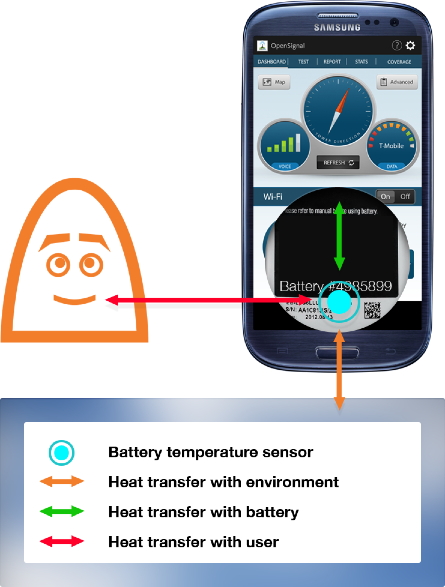Temperature Modeling and Management In Mobile Devices
Power dissipated by electronic circuits is converted into heat causing an increase in the device temperature. High temperatures negatively impact performance, raise leakage power consumption and can damage circuits . When temperature reaches a critical threshold, the system needs to be cooled down. In servers and enterprise systems, this is achieved with the use of fans and air conditioning. Most desktops and laptops also use fans to quickly remove the heat spread by computing circuits. Since the temperature of circuits has a linear dependence on power, it can also be reduced by managing operating conditions such as operating frequency and number of active cores. In the case of mobiles, there are additional problems that make thermal control particularly challenging. First, since mobiles are battery powered and have a reduced form factor, they cannot implement active cooling solutions such as fans, but can only rely on dynamic thermal management. Due to limited memory and computational resources, thermal models for predictive approaches should have a low overhead, which motivates the use of model identification techniques. Finally, high temperatures are a concern for skin contact, since mobiles are handheld devices. For example, a temperature on the back of a smartphone higher than 45oC is a source of discomfort for users.
The strategy of adapting operating conditions at runtime to maintain temperature in a safe range is Dynamic Thermal Management (DTM), and it is usually implemented by the operating system. Thermal management has been well investigated for traditional systems , but these do not account for user experience. Thermal management techniques can be reactive or proactive. Reactive techniques take decisions based on the current and past thermal state of the system. For this reason, reactive thermal management must set a conservative threshold value, thus leading to performance penalties. Proactive techniques, instead, leverage a thermal model to make predictions on the future impact of control decisions, to fully exploit the available thermal margin. It keeps the temperature as close as possible to the thresholds during intervals with heavy work loads, and improve overall performance. The main challenge associated with proactive thermal management is the identification of a thermal model for the target device, and its use within a control loop . A compact thermal model can be identified on the target device by exploiting readings from integrated thermal sensors. This is usually done by measuring temperature and power on the target platform and identifying an input-output system as a state-space model. It is possible to demonstrate that temperature can be represented with a linear time-invariant model, which is easy to store and to execute at runtime on a mobile device. Model identification of a compact thermal model is a practical and effective solution to implement with dynamic thermal management, and it is well-suited for mobile devices. Similar to power management, it is important to deploy dynamic thermal management techniques on real devices to obtain feedback and determine user experience. Thermal management is also useful to mitigate the impact of transistors and interconnects degradation mechanisms. These have an exponential dependency on temperature and can lead circuits to early failure. Unfortunately, thermal management alone does not account explicitly for the impact of reliability mechanisms. This is fundamental to meet product’s lifetime requirements.
https://escholarship.org/uc/item/7s30t876



